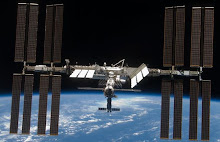
This image provided by NASA this July 23, 2009 is a photo made by the Spitzer Space Telescope of the galaxy, called NGC-1097, is located 50 million light-years away. It is spiral-shaped like our Milky Way, with long, spindly arms of stars. The 'eye' at the center of the galaxy is actually a monstrous black hole surrounded by a ring of stars. In this color-coded infrared view from Spitzer, the area around the invisible black hole is blue and the ring of stars, white. The black hole is huge, about 100 million times the mass of our sun, and is feeding off gas and dust along with the occasional unlucky star. The galaxy's red spiral arms and the swirling spokes seen between the arms show dust heated by newborn stars. Older populations of stars scattered through the galaxy are blue. The fuzzy blue dot to the left, which appears to fit snuggly between the arms, is a companion galaxy. This image was taken during Spitzer's cold mission, before it ran out of liquid coolant.
(AP Photo/NASA)

This infrared picture provided by NASA's Spitzer Space Telescope Wednesday Aug. 5, 2009 shows a cloud, known as DR22, bursting with new stars in the Cygnus region of the sky. Spitzer's infrared eyes can both see through and see dust, giving it a unique view into star-forming nests. The blue areas are dusty clouds, and the orange is mainly hot gas. The image is on of the first to be taken during Spitzer's warm mission -- a new phase that began after the telescope, which operated for more than five-and-a-half years, ran out of liquid coolant. (AP Photo/NASA/JPL-Caltech) This image is one of the first to be taken during Spitzer's warm mission -- a new phase that began after the telescope, which operated for more than five-and-a-half years, ran out of liquid coolant. The picture was snapped with the two infrared channels that still work at Spitzer's still-quite-chilly temperature of 30 Kelvin (about minus 406 Fahrenheit). The two infrared channels are part of Spitzer's infrared array camera: 3.6-micron light is blue and 4.5-micron light is orange. This picture was taken while the telescope was being re-commissioned, on July 21.



No comments:
Post a Comment